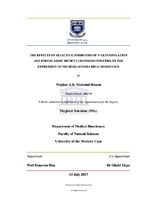| dc.contributor.advisor | Hiss, Donavon | |
| dc.contributor.advisor | Ekpo, Okobi | |
| dc.contributor.author | Husein, Wejdan A.B. Mahmud | |
| dc.date.accessioned | 2018-07-31T13:34:46Z | |
| dc.date.available | 2018-07-31T13:34:46Z | |
| dc.date.issued | 2017 | |
| dc.identifier.uri | http://hdl.handle.net/11394/6138 | |
| dc.description | Magister Scientiae - MSc (Medical BioSciences) | |
| dc.description.abstract | Neuroblastoma (NB) represents 8-10% of all childhood tumours and accounts for
approximately 15% of all cancer-related deaths in the paediatric population. Approximately
half of newly diagnosed children with this tumour will present with metastatic disease or
histologically aggressive large tumours that are at high risk for treatment failure. Since NBs
are often widely disseminated and the tumours genetically heterogeneous in terms of their
growth and metastatic behaviour, it is challenging to pinpoint their origin and predict disease
prognosis. Several risk factors have been identified to play a role in disease progression,
including age at the time of initial presentation, tumour stage, histology and ploidy of the
tumour, and cytogenetic aberrations such as MYCN amplification, anaplastic lymphoma kinase
(ALK), loss of heterozygosity of 11q and gain of 17q chromosomes. | |
| dc.language.iso | en | |
| dc.publisher | University of the Western Cape | |
| dc.title | The effects of selective inhibitors of n-glycosylation and endoplasmic reticulum stress inducers on the expression of neuroblastoma drug resistance | |
| dc.rights.holder | University of the Western Cape | |

